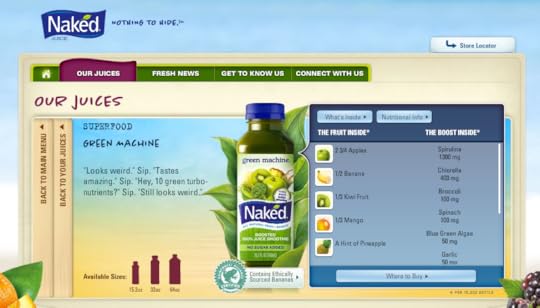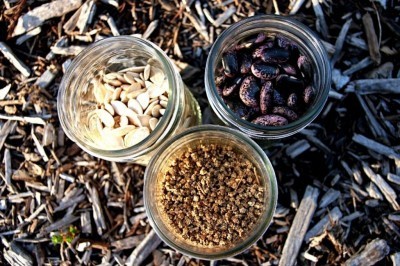Jeff Potter's Blog, page 3
November 12, 2015
Why Can’t We Just Eat Grass?
 A friend of mine who works in food policy, talking with random member of the public: Random person: Why can’t we just eat grass? Friend: Because we aren’t cows. Random person: But I’m a vegetarian.
A friend of mine who works in food policy, talking with random member of the public: Random person: Why can’t we just eat grass? Friend: Because we aren’t cows. Random person: But I’m a vegetarian.
November 11, 2015
Ingredient Labels—Watch Out for This One Trick!
 I wrote this up a few years ago but let it languish in my “thoughts” pile—clicking the “publish” button at last. Following up on yesterday’s comments about the US FDA’s proposal to change the food label by adding “added sugars” with a percent daily value is this below gem. I’m not sure it’s going to … Continue reading Ingredient Labels—Watch Out for This One Trick!
I wrote this up a few years ago but let it languish in my “thoughts” pile—clicking the “publish” button at last. Following up on yesterday’s comments about the US FDA’s proposal to change the food label by adding “added sugars” with a percent daily value is this below gem. I’m not sure it’s going to … Continue reading Ingredient Labels—Watch Out for This One Trick!
November 10, 2015
Sugar Recommendations—And What We’re Missing About Them
 Today’s New York Times has a Well Blog post on the FDA’s proposal to change how sugars are labeled in foods. There’s lots that can be said about this (primarily “Yay!”), but here are some quick thoughts about what I think people are missing about the sugar recommendations. Are you aware that the current food … Continue reading Sugar Recommendations—And What We’re Missing About Them
Today’s New York Times has a Well Blog post on the FDA’s proposal to change how sugars are labeled in foods. There’s lots that can be said about this (primarily “Yay!”), but here are some quick thoughts about what I think people are missing about the sugar recommendations. Are you aware that the current food … Continue reading Sugar Recommendations—And What We’re Missing About Them
For more, see Jeff Potter's Cooking for Geeks.
Sugar Recommendations — And What We’re Missing About Them
 Today’s New York Times has a Well Blog post on the FDA’s proposal to change how sugars are labeled in foods. There’s lots that can be said about this (primarily “Yay!”), but here are some quick thoughts about what I think people are missing about the sugar recommendations. Are you aware that the current food … Continue reading Sugar Recommendations — And What We’re Missing About Them
Today’s New York Times has a Well Blog post on the FDA’s proposal to change how sugars are labeled in foods. There’s lots that can be said about this (primarily “Yay!”), but here are some quick thoughts about what I think people are missing about the sugar recommendations. Are you aware that the current food … Continue reading Sugar Recommendations — And What We’re Missing About Them
October 20, 2014
Does Baking Soda Make Omelets Fluffier?
 Questions about baking soda? Both baking soda and baking powder can be mysterious, but they’re actually pretty easy to understand once you view them with some science in mind.
Questions about baking soda? Both baking soda and baking powder can be mysterious, but they’re actually pretty easy to understand once you view them with some science in mind.
Reader Q on Baking Soda
I’ve found a few recommendations floating around the internet that suggest you could use baking soda to make fluffier omelets, to tenderize meat or even as an additive to beans to reduce “bean bloat”. Do you know if there might be any truth to these? If so, why would they work? I’d also love to know if you have any other ideas for unexpected ways someone could use baking soda in cooking.
-Jade
Hi Jade —
Both baking soda and baking powder can be mysterious, but they’re actually pretty easy to understand once you view them with some science in mind.
First, baking soda: it’s a single compound — sodium bicarbonate — that reacts with other ingredients and produces carbon dioxide. When sodium bicarbonate gets added into your other ingredients, it dissolves into just sodium and bicarbonate. The sodium adds a salty taste (just like sodium chloride does), but it’s the bicarbonate that’s useful: it can react with other acid compounds (vinegar, lemon juice, buttermilk) to generate gas, or when heated up, will break down on its own and generate carbon dioxide.
Baking powder is like baking soda, but is made of more than one compound. It’s what I call a “self contained leaving system” — it’s got everything you need to lighten food. Baking powder is usually composed of baking soda and an acid such as cream of tartar or monocalcium phosphate. Add water, and poof! The ingredients dissolve and can react with each other. (In powder form, they don’t interact very quickly — but can, over time — so if your baking powder is a few years old, it won’t work very well.)
So now that we have the definitions out of the way, what can we do with them? Baking soda, as a single compound, can be used anywhere there the chemical reaction between the bicarbonate and another compound leads to a change. (Of course, if you add too much baking soda, it won’t completely react — there’ll be left over baking soda that then interacts with your taste buds and tastes nasty.)
You’d asked how baking soda would make an omelet fluffier. Eggs are surprisingly basic; I wouldn’t think of them as having acids that the baking soda can react with. Baking soda does decompose into carbon dioxide and water with heat, though — it looks like this begins around the boiling point of water — so it’s possible that that would be a mechanism. Honestly, though? If I wanted a light, fluffy omelet, I would separate the eggs white and the egg yolks, whisk the egg whites some, and then mix the yolks back in. “Fluffy” means air, and using baking soda is just one way of doing it (chemically). You can “add” air in mechanically, and avoid the potential change in flavor from the baking soda.
As for adding baking soda to beans: according to the US Dry Bean Council — this is a private industry group of folks who grow and sell beans — adding baking soda will make beans more tender (which you’d only want to do if your beans are coming out too tough). They don’t mention anything about baking soda and bloat; however their answer on “gas-causing properties of dry beans” looks reasonable, See: www.usdrybeans.com/nutrition/nutrition-facts/
You might skim books.google.com/books?id=yb4B-19xm-MC and books.google.com/books?id=at4WAwAAQBAJ — I don’t know how much I’d trust these, since they’re recent ebook of low quality, but it’s an interesting place to see what’s commonly believed (true or not) that you might be able to then dig into. For example, baking soda in the fridge to absorb odors is not something that I believe works — and here’s a link to “Ask a Scientist” saying as much at the Department of Energy (who I would believe): www.newton.dep.anl.gov/askasci/chem00/chem00388.htm
Hope this helps! I’m going to wander off to my kitchen to make two different omelets — one with baking soda — to see if there’s any truth to the idea.
best,
Jeff
November 21, 2013
Troubleshooting Turkey on Science Friday
 Just a brief note to say that I’ll be on Science Friday this Friday around 2:30 PM ET / 11:30 AM PT, talking with Ira Flatow about Thanksgiving and how science can help you avoid disaster. Listen in and tweet your questions at us at @scifri ! …and that’s a wrap. If you missed it, … Continue reading Troubleshooting Turkey on Science Friday
Just a brief note to say that I’ll be on Science Friday this Friday around 2:30 PM ET / 11:30 AM PT, talking with Ira Flatow about Thanksgiving and how science can help you avoid disaster. Listen in and tweet your questions at us at @scifri ! …and that’s a wrap. If you missed it, … Continue reading Troubleshooting Turkey on Science Friday
Troubleshooting Turkey
I know, I’ve been really, really bad about blogging… I’m a much better book author than I am a blog writer.
Just a brief note to say that I’ll be on NPR’s Science Friday this Friday, November 22nd, around 2:30 PM ET / 11:30 AM PT, talking with Ira Flatow about Thanksgiving and how science can help you avoid disaster. Listen in and tweet your questions at us at @scifri !
-Jeff
June 23, 2012
Thoughts on GM Grass Killing Texas Cattle
[image error]
CBS News ran a story titled “GM grass linked to Texas cattle deaths” earlier today. In a nutshell, the story reports that 15 cows died from cyanide poisoning after eating genetically modified grass. See www.cbsnews.com/8301-201_162-57459357/gm-grass-linked-to-texas-cattle-deaths/ for more.
There’s a pretty clear culprit, from the reporting thus far: cows die from cyanide poisoning, grass tests positive for cyanide, so the grass did it. If I were on the jury, I’d definitely vote guilty. But why start the headline with “GM grass”?
Questions I Have:
How often do plants produce compounds that can lead to cyanide poisoning? The story sounds horrific: Fields of cyanide gas… animals passing out… queue WWII flick… (Or Wizard of Oz?) But plenty of plants produce toxins like cyanide to keep themselves from being eaten. A quick Google search for “cyanide grass” and a quick peak on pubmed for cyanide poisoning shows a few interesting things, among them: “Southeastern plants toxic to ruminants: Selected toxic plants affecting cattle, sheep, and goats in the southeastern United States are presented…” (I really hate paywalls on journals, by the way.)
For cyanide specifically, I know that some seeds (like apple seeds) contain trace amounts. It’s not unnatural for plants to produce these types of compounds. Skim through www.aces.edu/pubs/docs/A/ANR-0975/ANR-0975.pdf — there are plenty of plants that rank right up there with things I’d suggest skipping. (Anyone know the writers for House M.D.? They should check out a plant called white snakeroot: cows can tolerate eating it but the milk they then yield can kill humans.)
Did the grass that killed these cows produce levels of cyanide-based toxins on par with what other poisonous wild plants produce? I.e. are we dealing with a true horror flick here, where a new Big Bad has come to town that we’re gonna need help slaying? And a follow-up question, does any common grass normally produce cyanide, but at such low levels that there’s no impact? (“Dosage matters!”)
What is Tifton 85? How was it made? All plants are capable of cross-breeding and mutating. From reading online, Tifton 85 is a crossbreed (good ol’ fashion breeding, just like Mom and Pop used to make) between “a South African grass and Tifton 68.” I can’t find much about Tifton 68, which has been around since at least 1984, possibly longer. (By the way, Tifton grasses are breed and created by the United States Department of Agriculture research station in Tifton, Georgia; the number refers the to the specific variant; so higher numbers are newer.)
Is there something specific about Tifton 85 or the GM process used to make it that lead to the mutation? I believe a lot of viewers will see the phrase “GM grass” and automatically assume that it’s the “GM” aspects that caused the grass to mutate. But based on the dates for Tifton 68, I’m not even sure that Tifton grass could be GM in the modern sense; i.e. more than just conventional cr0ss-breeding. (Yes, cross-breeding changes the genes. Just like your genes are a combination from your two parents.) If Tifton 85′s lineage consists of only crossbreeding, then I think it’s unfair to call it “GM Grass”, as the common usage of GM has come to mean genetically engineered (“things that could never happen in Nature”). Do you think that this is a fair distinction?
Other questions you want answers to? Anwers and critiques to my notes, of course, also appreciated.
P.S. If you’ve not seen Just Label It, check out http://justlabelit.org/
February 9, 2012
Awesome Food: UCSC Seed Library

I'm pleased to announce this month's Awesome Food micro-grant! If you're into gardening and near Santa Cruz, you should definitely stop by Andrew's monthly seed exchange. -Jeff
UCSC Seed Library Receives February Awesome Food Grant
Awesome Food is happy to announce that its fifth micro-grant of $1,000 has been awarded to Andrew Whitman of the UCSC Seed Library, which is a seed repository and lending service based at the University of California at Santa Cruz. Whitman is among nearly 800 applicants from around the world who have applied for grants from Awesome Food, a chapter of the Awesome Foundation, which awarded its first micro-grant in October 2011.
The UCSC Seed Library was started in 2011 by Whitman, a fourth year History major at UCSC, as a way to catalog and preserve local seed varieties, in order to combat the increasing homogeny that comes from commercial growing.
A seed library is a means by which a region can store the genes of its traditional heirloom varieties, teach the public about farming and biology, and store alternative species of plants in case widely-used varieties succumb to a new disease or pests. The UCSC Seed Library works by lending a certain amount of seeds to a farmer or gardener, who grows those seeds into a crop, and then returns the same amount of seeds he or she had previously borrowed. So far, the UCSC Seed Library has approximately 83 varieties of regionally-adapted, organic seeds which are available for lending.
Some recent studies have shown that our crop diversity has decreased by as much as 93% in the last century. For example, there were over 7,000 varieties of apples in the 1800s. Now, there are fewer than one hundred. Awesome Food trustee Leah Lizarondo Shannon, of The Brazen Kitchen, considers the UCSC Seed Library to be awesome because "it brings awareness and proposes a solution that can mitigate the impact of dwindling diversity to our food security."
"Moreover," added Shannon, "if universities across the US replicate this initiative, we can begin to build the equivalent of a distributed and localized "food ark" — mirroring the mission of initiatives such as the Svalbard International Seed Vault."
Whitman is passionate about the importance of preserving local seed varieties, especially since the farming practice of planting large crops of genetic similarity — also known as monocultures — have become dominant. "Biodiversity is an integral part of any healthy ecosystem. Having a diverse gene pool is a natural means for coping with potent diseases, environmental stress, and quick changes in the ecosystem," he said. "Unfortunately, our current food system promotes massive contracted monocultures that a few key distributors package and send throughout the nation and world."
He points out that, while there are some seemingly positive aspects to monocultures, one major downfall is that monocultures are more susceptible to widespread extermination by mutating diseases or pests. Maintaining biodiversity in agriculture can help ensure that, even if one strain is killed off, others can still survive.
Whitman plans to use the Awesome Food grant not only to purchase more supplies for the physical seed library but also to raise awareness of the UCSC seed lending and tracking model. He is already working with students at the University of California at Davis to help them begin to build their own institutionally anchored seed library. Whitman hopes to travel to other universities in an effort to promote the UCSC model and to encourage other institutions to follow suit for their local communities. "It is the goal of this project to help preserve the local varieties of the Central Coast," said Whitman. "I hope this model can be applied to other regions, so they can help preserve their own local biodiversity."
Anyone — from novice home gardeners to more experienced farmers — can borrow seeds from the UCSC Seed Library. Whitman also holds monthly seed exchanges at UCSC. For more information or to get involved, please contact Andrew Whitman at awhitman[at]slugmail.ucsc.edu.
(Photo by Alexandra Villegas)



